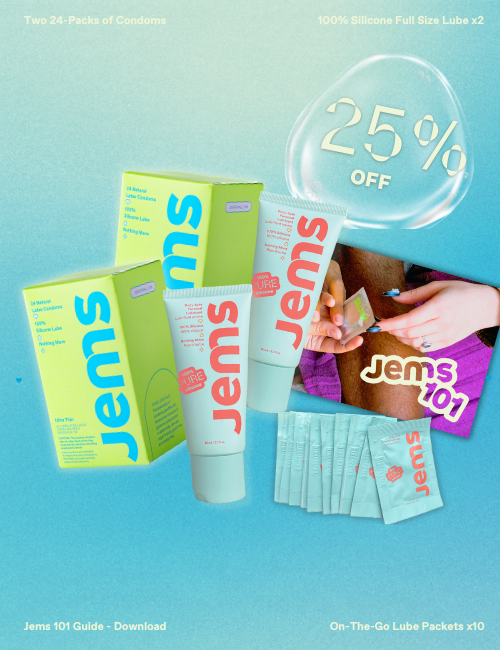FAQ
Yes! The Jems condom is a staple of safer sex. Not only are condoms one of the safest and most effective forms of birth control and STI/STD transmission prevention (when it comes to HIV, using a condom makes sex 10,000 times safer than not using a condom), Jems condoms are made of trusted ingredients – we use only what’s essential. Unlike some other condom brands, Jems are free of potentially harmful ingredients including parabens, paraffins, talc, benzocaine, nonoxynol-9, glycerine, cetyl alcohol, and spermicide. See our next question for a list of ingredients.
All Jems condoms are electronically tested for safety. Batch testing includes air burst testing, dimensional testing and leak testing. Condoms are considered a Class II medical device. Jems condoms are cleared by the USA FDA. Jems also meets all regulatory requirements set out by Health Canada and are certified and approved under the Medical Device Regulations.
Always be sure to open, store and use your condoms correctly for maximum effectiveness.
Jems condoms are made of two main ingredients: natural rubber latex and silicone lube. The product also has trace amounts of a cornstarch and magnesium carbonate dusting powder that is used in the manufacturing process.
Jems keeps it simple, for your safety, unlike some other condom brands which use unnecessary and unlisted ingredients that can be harmful. Ingredients you should watch out for include nonoxynol-9, a spermicidal detergent that can cause inflammation and infection; glycerin, a preservative popular in warming and flavored lubes that offers no protective benefits and may increase risks of yeast infections; cancer causing parabens; casein, a milk protein; and benzocaine, a topical anesthetic which can cause irritation and inflammation. Jems condoms contain none of that. Our condoms are made of simple, effective ingredients, and nothing more. Oh, and they’re vegan and gluten free.
A small percentage of people (less than 1% in the United States according to the Asthma and Allergy Foundation of America) are allergic to latex, which Jems condoms are made of. If you think you may be allergic, it’s best to avoid contact with latex products, such as balloons, rubber gloves, and latex condoms, and get tested with a medical professional to be sure. Because condoms are such a popular and reliable safer sex product, there are latex-free options made of polyurethane and polyisoprene. Jems only makes latex condoms so far.
Jems condoms are ultra-thin. They come in one standard thickness - 0.055 mm.
Condom thickness is a hotly contested issue and often a bit of a marketing ploy. The difference between a thick and thin condom is tiny, to say the least. We chose to make Jems condoms ultra-thin, keeping you closer to your partner, without compromising what condoms are made to do: keep you safe.
Jems condoms come in one standard size and should fit most phalluses. Latex condoms, after all, can stretch a lot.
Jems condoms are 180mm in length (before stretching) with a 15mm reservoir head. Their shape is parallel sided, with a (before stretch) width of 53mm (±2mm) at the base and through the mid-body of the condom.
If you want a more tactile understanding of sizing, we recommend you try a Jems condom on before using, or make a balloon out of one – you’ll find our condoms can hold a lot of volume.
Yes! Jems condoms are made from trusted ingredients, using only what’s essential, without any animal products. They’re also gluten free.
What’s the shelf life of Jems condoms? Where should I keep my condoms?
Each Jems condom is usable until the expiration date, which is 5 years from the day that it’s foiled. The expiration date is always printed on the foil. Never use an expired condom.
Always store latex condoms at room temperature and out of direct sunlight. Be careful not to tear or puncture the condom while opening the foil and be wary of condoms that may have sustained damage in your wallet, pocket, or the bottom of your purse. We recommend keeping your condoms in a safe place, or treating yourself or your partner to one of our carrying cases to help protect your condoms.
It can take a little practice, don’t worry. Every box of Jems condoms purchased on our webshop comes with clear step-by-step instructions composed with the broadest possible audience in mind, including nonbinary, transgender, and gender expansive condom users. When in doubt, watch YouTube.
Yes! But make sure to use the right ones. Never use oil-based lubes like Vaseline, lotion or coconut oil with Jems condoms, as oil can cause latex to break down. Water-based and silicone lubes, on the other hand, are safe and can increase pleasure and comfort. You can put a few extra drops of water-based or silicone lube inside your Jems condom before putting it on. Outside, use as much as you desire! If you don’t have extra lube, don’t worry: Jems condoms are lubricated already. Some people just like it extra wet and gushy.
No. No method is 100% effective in preventing the transmission of STDs and HIV. This is why Jems calls it ‘safer sex’ rather than ‘safe sex.’ Jems is about providing as much information and context as possible so individuals can understand, weigh, and reduce risk on their own terms.
When used consistently and correctly, condoms are a highly effective protection against many sexually transmitted diseases and infections (STDs and STIs) such as chlamydia, gonorrhea and trichomoniasis – reducing the risk of HIV transmission by up to 98%. This is done by providing a protective barrier from skin-to-skin contact and preventing the exchange of bodily fluids (such as semen). Condoms also reduce the exchange of irritating bacteria.
We recommend you educate yourself on the different kinds of STDs and STIs (Planned Parenthood is a great resource). Since some STD/STIs have no symptoms, you could have one, not know it, and potentially pass it on to your partner(s). If you’re sexually active, regular STD/STI check-ups are highly recommended, every six months or between partners – ask your doctor or research local sexual health clinics. Many clinics around the world offer free anonymous STD and STI testing. There’s no shame in getting tested. Monitoring your sexual health protects not only you, but any potential partner(s).
No. No birth control method is 100% effective in preventing pregnancy. This is why Jems calls it ‘safer sex’ rather than ‘safe sex.’ Jems is about providing as much information and context as possible so individuals can understand, weigh, and reduce risk on their own terms.
If you used absolutely perfectly, consistently, and correctly, condoms are about 98% effective at preventing pregnancy. This is done by providing a protective barrier which prevents pre-cum and cum/ejaculate/semen (which contains sperm) from a male reproductive system from entering the vagina/vaginal canal/cervix of a female reproductive system, where it may fertilize an egg. If worn correctly, semen is captured in the reservoir tip of the condom preventing pregnancy.
If you or your partner are concerned about pregnancy, you may consider exploring other birth control options in addition to correctly and consistently using condoms.



